| Reviews & Columns |
|
Reviews DVD TV on DVD Blu-ray 4K UHD International DVDs In Theaters Reviews by Studio Video Games Features Collector Series DVDs Easter Egg Database Interviews DVD Talk Radio Feature Articles Columns Anime Talk DVD Savant Horror DVDs The M.O.D. Squad Art House HD Talk Silent DVD
|
DVD Talk Forum |
|
|
| Resources |
|
DVD Price Search Customer Service #'s RCE Info Links |
|
Columns
|
|
|
Hunger Games: Complete 4 Film Collection, The
Lionsgate Home Entertainment // PG-13 // March 22, 2016
List Price: $64.97 [Buy now and save at Amazon]
The Series:
The stars aligned almost perfectly when the creative process began for The Hunger Games, an adaptation of Suzanne Collins' trilogy of young-adult dystopian books. As the author was finishing up the final novel, the Harry Potter film franchise was coming to an end, leaving a void in the cinema world for a new pop-culture series that fit in with a similar target audience. Jennifer Lawrence was cast in the role of Katniss Everdeen, the teenage heroine who would eventually become the spirit of an uprising, right around the time she received an Oscar nomination and was gearing up to play one of the primary mutants in the latest X-Men film. It hasn't been all apple tarts and white roses for the series since then, though, brushing with some kind of mild controversy every step of the way toward the Capitol, from concerns over the violence toward children and racial casting to the switch in directors mid-series. That didn't stop The Hunger Games from becoming its own worldwide phenomenon, and while consistency isn't its strong suit, there's plenty of meaningful exhilaration found in its four entries.
Director Gary Ross can be attributed to lighting the spark that started it all with The Hunger Games, bringing his experience with intimate, resolute drama to the world of Panem. While his enthusiasm toward evoking realism in the setting led to a consistent amount of shaky camerawork that could, occasionally, be distracting, there was a very clear focus on the new emotions erupting in Katniss Everdeen, the sixteen-year-old who volunteers to take her sisters place in the Reaping, the annual government-orchestrated, to-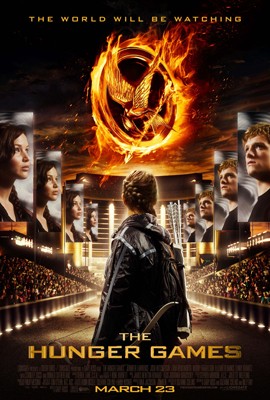 the-death battle royale among randomly-chosen youths. Through the spectacle of the Games -- the beautification and training of the young contestants, the glorification of the violence ultimately unleashed between them in the area, and the use of on-screen romance as a tool for popularity -- the film captures Suzanne Collins' commentary on media manipulation and pop-culture's fascination with reality TV and violence. With Lawrence's obstinate determination as Katniss driving the character through the bloodshed in this haunting new dystopian atmosphere, it transforms into a meaningful and intense adaptation.
the-death battle royale among randomly-chosen youths. Through the spectacle of the Games -- the beautification and training of the young contestants, the glorification of the violence ultimately unleashed between them in the area, and the use of on-screen romance as a tool for popularity -- the film captures Suzanne Collins' commentary on media manipulation and pop-culture's fascination with reality TV and violence. With Lawrence's obstinate determination as Katniss driving the character through the bloodshed in this haunting new dystopian atmosphere, it transforms into a meaningful and intense adaptation.
Concerns surfaced when director Ross didn't volunteer to return to the world of Panem, later replaced by I Am Legend director Francis Lawrence, setting the franchise up for potential inconsistency and arguable fluctuations in quality. Surprisingly, the second installment, Catching Fire, takes the familiar components of Collins' book (and the first film) and improves upon them, focusing on the mental anguish suffered by Katniss in the previous games and how she's transforming into the face of a rebellion alongside her condition. A second, more violent and morbidly creative games ensues, and while there's some resemblance in the structure of the plot between the two stories, the progressing themes of oppressive government control and the twisting of public perceptions takes the tone in an invigorating, dangerous direction. Complimented by Jennifer Lawrence's addled embodiment of post-traumatic stress and a vivid, twist-heavy second round in the Hunger Games arena designed by Philip Seymour Hoffman's gamemaker, Catching Fire stands firm as the strongest entry in the series.
Following the box-office savvy trend set by Harry Potter and Twilight, Mockingjay took the unfortunate turn into splitting up the third installment of Suzanne Collins' novel series -- one that already had received mixed reviews -- into two halves. The positive of this could've potentially come in director Francis Lawrence dedicating more time to elevating the buildup to the harrowing grand finale, granting Katniss more time to decompress following her continued ordeals and sort out her relationships. What instead happens, as can be predicted, is a straight, elongated division of the book: Mockingjay Part 1 struggles to fill its time with pertinent information and excitement, resulting in two hours of drab buildup around the young heroine losing her agency and becoming a weapon for the resistance. While the shift makes sense, it's a stark deviation from the stories of the previous Hunger Games films, and that isn't helped by the fact that the action side of the final novel lies waiting in the second half. Like this, Part 1 feels like little more than anticipation, a serviceable prologue to revolution that doesn't achieve enough to justify the expanded time.
The Hunger Games: Mockingjay Part 2
The writing was on the wall as soon as the announcement was made: that the third book in Suzanne Collins' Hunger Games series, "Mockingjay", would be split into two films. The idea is intrinsically flawed, driving a partition somewhere in the middle -- around the rising action -- of a story that's built with a beginning and an end, leaving one standalone film to concentrate on the build-up and the other as the payoff. It was a disheartening creative decision, especially after director Francis Lawrence surprised audiences with Catching Fire, often considered to have improved upon the successes of the first Hunger Games. Yet, the possibility arose that, perhaps, the added length and the cinematic format might better realize the material that received a polarized response from the series' fans, giving the first half more substance and purpose while more clearly visualizing the vigorous war-torn second half. Alas, the division was clearly apparent in the dreary and unsatisfying Mockingjay Part 1, leaving Part 2 to follow through roughly as expected: two-plus hours of danger, death, and despair that'd have more impact had it seamlessly flowed from the first.
Naturally, Mockingjay: Part 2 picks up immediately after the abrupt ending of the previous film (which should be viewed before continuing with this review), where resistance leader Coin (Julianne Moore) announced plans to move forward on the Capitol and where the group of Hunger Games victors who were captured by President Snow's forces -- including Peeta Mellark (Josh Hutcherson) -- have been rescued and brought to the fabled District 13. There's little else to do at this point than for the face of the resistance, Katniss Everdeen (Jennifer Lawrence), to lead her push onto the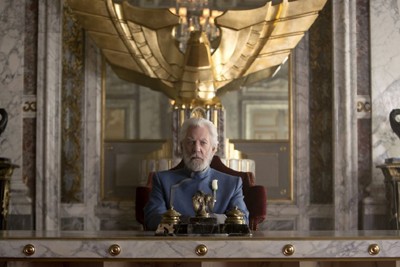 Capitol, though the conflicted attitudes within the resistance leave her in a state of flux as to whether she's supposed to kill Snow (Donald Sutherland) or not. Katniss, ever decisive and rebellious, makes her own choices about what to do once the troops arrive in the landscape of the Capitol, which has been rigged into a grand spectacle of violent traps for the resistance fighters to progress through, quite similarly to that of another spectacle in the Hunger Games.
Capitol, though the conflicted attitudes within the resistance leave her in a state of flux as to whether she's supposed to kill Snow (Donald Sutherland) or not. Katniss, ever decisive and rebellious, makes her own choices about what to do once the troops arrive in the landscape of the Capitol, which has been rigged into a grand spectacle of violent traps for the resistance fighters to progress through, quite similarly to that of another spectacle in the Hunger Games.
By virtue of being the response to the events in Mockingjay Part 1 and the grand finale in a series about political and paramilitary rebellion, it's unsurprising that Mockingjay Part 2 revolves almost entirely around the brutal action of the storm upon the Capitol. Despite complex character moments beforehand that heighten the emotional gravity of the events to come, there's no stopping the momentum forcing the film forward, as if very little has a purpose beyond spurring Katniss toward her duty. While that's part and parcel with the division of stories, the script from Peter Craig and Daniel Strong also relies on an exorbitant amount of dull exposition to elaborate on what's going on, failing to elevate the inherently grim tone of warfare leading the resistance forward. Beyond the scenes with Peeta, driven by an unleashed and wild-eyed performance from Josh Hutcherson whose character now suffers from his own post-trauma distortion, there's a stony and generally obligatory attitude about the second part here. The intentionally silent presence of Philip Seymour Hoffman doesn't help.
Across the Hunger Games series, Katniss Everdeen transforms dramatically, erupting from a emotional sister who stands in for her sibling in the face of certain death into a warrior with PTSD and, eventually, to the televised face of rebellion against dictatorship. Mockingjay Part 2 marks the end product of her trials, and it isn't pretty: born of necessity, she's become severe and driven by vengeance, sustaining her composure for the good of those around her. It's a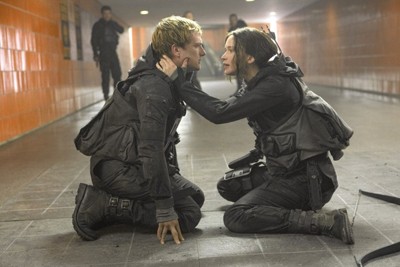 logical metamorphosis, of course, but it also takes away from the enlivened strength that Lawrence's acting ability brought to the table, relying more on suppressed -- often nondescript -- expressions of anguish. There's strength in that, depicting a resolute woman who steels herself for the betterment of her comrades: for her sister, a burgeoning medic; for Peeta, whose brainwashing has given him murderous tendencies; and for Gale, who turned pragmatically ruthless for the sake of the resistance after the destruction of his home. Outside of a few fiery scenes where Katniss is (finally) allowed to let her guard down, this is a stark -- numbed, even -- portrayal that's tough to relish.
logical metamorphosis, of course, but it also takes away from the enlivened strength that Lawrence's acting ability brought to the table, relying more on suppressed -- often nondescript -- expressions of anguish. There's strength in that, depicting a resolute woman who steels herself for the betterment of her comrades: for her sister, a burgeoning medic; for Peeta, whose brainwashing has given him murderous tendencies; and for Gale, who turned pragmatically ruthless for the sake of the resistance after the destruction of his home. Outside of a few fiery scenes where Katniss is (finally) allowed to let her guard down, this is a stark -- numbed, even -- portrayal that's tough to relish.
The vast majority of Mockingjay Part 2 revolves around this despondent Katniss leading the physical uprising throughout the Capitol, which President Snow has shaped into a grand spectacle by setting vicious booby-traps throughout the city to thwart their efforts. In essence, that becomes the final version of the "games" within the series, and it doesn't shy away from bountiful violence and death within the space of a PG-13 film. Collins' third book struggled in this area: while her writing style capably fleshed out the creativity of gamemaker arenas, her depiction of the modified city streets resulted in fast-moving but obscured warfare that didn't have a firm grasp on the landscape. The cinematic medium obviously has an advantage there, and it's one of final chapter's true strengths, perpetuating the gray, crumbling atmosphere of upheaval with the dangers of liquid, fire, and bloodthirsty monsters unleashed on Katniss and her infiltrators. Fierce action ensues, and while the skirmishes and battlefield are still jumbled and not without a few holes, director Lawrence nails the harrowing blockbuster intensity.
That's also part of the problem with Mockingjay Part 2 as a whole, though: it essentially feels like the Reaping portion of the prior films has been cut off and extended into its own installment, only with Katniss descending into the warzone of districts instead of being elevated upwards through a cylindrical tube. The series' signature gloomy tones built around sacrifice, politics, and manipulation of citizens with media and propaganda weave together with the intense action, further amplified by commentary on the price of war and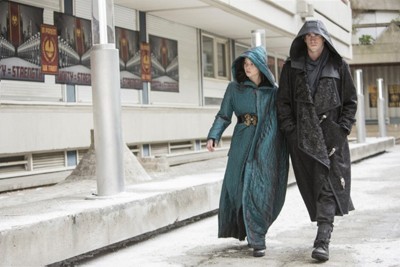 the demands of political power upon rulers. Director Lawrence and his writers bring all this together into a functional and twist-heavy commentary, yet viewing the tribulations of the resistance fighters and the lengths in which powerful figures will go to assert their grasp over the masses -- blatantly disregarding the value of life -- doesn't make for the same kind of rewarding or particularly enthralling experience found in Katniss' first bout in the arena or the Quarter Quell. The stakes are higher, but the the overcast demeanor continuously suppresses the excitement level.
the demands of political power upon rulers. Director Lawrence and his writers bring all this together into a functional and twist-heavy commentary, yet viewing the tribulations of the resistance fighters and the lengths in which powerful figures will go to assert their grasp over the masses -- blatantly disregarding the value of life -- doesn't make for the same kind of rewarding or particularly enthralling experience found in Katniss' first bout in the arena or the Quarter Quell. The stakes are higher, but the the overcast demeanor continuously suppresses the excitement level.
While the final installment in the Hunger Games series certainly understands its need for closure, heightened by splendid production value behind the action and convincing, emotional performances from all involved, there's no getting around that Mockingjay Part 2 -- much in the same way as Part 1 -- runs at least a half-hour longer than it should. A tighter and more poignant depiction of the uprising against the Capitol likely exists somewhere between these overlong productions, a brisk and intense sendoff instead of an elongated elegy. What's here instead musters a generally appropriate ending that fits somewhere in the space between sorrow and bittersweet, slightly more upbeat and optimistic in tone than the book but every bit as daunting in terms of how Katniss concludes her term as the Girl on Fire. Unfortunately, that comes at the end of a four-hour storming of the castle that can't shake the feeling that it deliberately padded its runtime for the sake of a two-part theatrical showing, a disappointment considering how director Lawrence skillfully took the torch and ran with Catching Fire.
The Blu-ray:
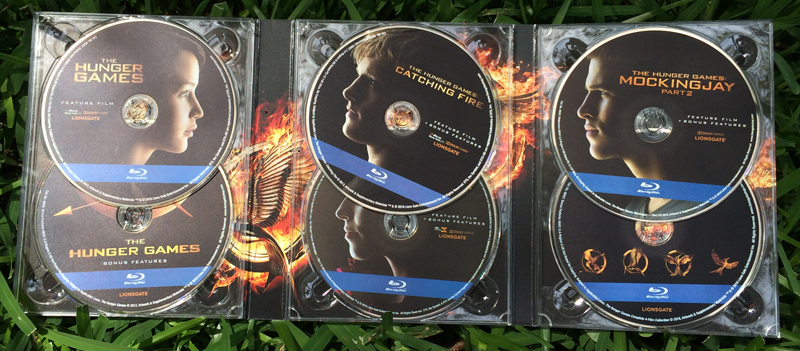
Packaged in a white outer box featuring the image of Jennifer Lawrence on the front and the three-finger salute silhouette on the back, The Hunger Games series comes bundled from Lionsgate in a relatively streamlined but appealing full-series box. They've taken measures to make this set not appear to be a cash grab: each of the discs, while identical in content to their respective individual releases, have unique artwork featuring the side profiles of the series' actors (posters from the first film); the foldout digipack housing for the discs comes with unique outer artwork featuring a progression from the first to final film; and a bonus disc has also been included, discussed later. The outer box has a nice mix of raised letters and glossy printing, and is thick enough to withstand a little abuse. A Digital Copy slip for all four films has also been included.
For full reviews of the three prior individual films and their respective Blu-ray releases, click each of the following links:
Video and Audio for Part 2:
Both parts of Mockingjay sport a noticeably gloomier, lower-color palette than the previous two entries, with Mockingjay Part 2 focusing even more on the crumbled, empty streets of the Capitol -- and another district -- and the dark channels lying underneath, lacking direct vividness and intricacy due to the absence of the Games. Therefore, the cinematography must find its visual delights in unconventional sources, such as the subtle teal shade of a robe in the low-color surroundings and shades of orange and yellow in fire and against walls. Lionsgate's 2.35:1-framed, 1080p AVC transfer keeps a steady perspective on that color palette, while latching onto fine textures for its high-definition delights, such as the tattoos on Natalie Dormer's shaved scalp and the weave of Katniss' body armor. Splashes of bizarre oil-like fluid and the the flood of flames create brisk-moving, well-represented details in the traps. Contrast leans light at certain points, but the depth remains largely natural and allows for distinct shots throughout the byzantine streets. The image can also appear somewhat smooth and drab throughout, part intentional and part due to the disc. In general, the impressions felt about the transfer echo those of the movie itself: not bad, but weaker than the previous installments.
Mockingjay: Part 2 storms onto Blu-ray with a Dolby Atmos track, which downscales to a fine Dolby TrueHD 7.1 track that packs more of a low-end punch than it does with immersing the surround stage with activity. Rushes of fire and floods of peculiar black fluid encompass the front end of the surround stage with vigorous activity, tapping into tight and expansive bass response. The sounds of bizarre creatures in tunnels, the zip of energy rays, and the ever-present rattling of gunfire hit robust high-end elements, while the crumble of walls and other sounds of warfare hit upon solid mid-range effects. Some surround activity does flow from the front-end to the back and vice versa, such as the zooming of the resistance's planes, but I was expecting more out of the back and back-center channels at many points throughout, leaving it sounding more front-heavy than expected. Dialogue, however, remains crystal clear and well-adjusted to middle-range balance at all points, and reacts well to the ambience of many different locations across the warzone.
Special Features for Part 2:
Commentary with Francis Lawrence and Nina Jacobsen:
If you've experienced the bonus features for the previous entries of The Hunger Games, then you'll know what to expect of this commentary with the director and producer: a laid-back discussion that does a better job at plugging up gaps of knowledge than standing out as an exciting track on its own. They touch upon the "numbed" nature of Katniss' character, the pleasure of working with a Game of Thrones star, and how much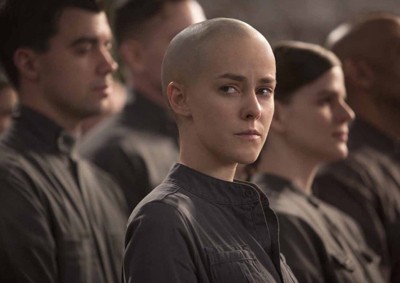 digital work went into creating the appearances of the people in the film (hint: it's a lot more than you'll expect). They also lightly discuss the decisions that went into separating the story into two halves and the direction they wanted to go in tandem with Suzanne Collins' wishes, having a lot of visual similarities that reference the previous films in their aesthetics, and capturing the "visceral" potency of the resistance's storm through the Capitol. The energy remains low yet steady throughout, but, as always, it's a nice supplement to the other features.
digital work went into creating the appearances of the people in the film (hint: it's a lot more than you'll expect). They also lightly discuss the decisions that went into separating the story into two halves and the direction they wanted to go in tandem with Suzanne Collins' wishes, having a lot of visual similarities that reference the previous films in their aesthetics, and capturing the "visceral" potency of the resistance's storm through the Capitol. The energy remains low yet steady throughout, but, as always, it's a nice supplement to the other features.
Pawns No More: Making The Hunger Games: Mockingjay Part 2 (2:21:45, 16x9 HD):
Finishing up the series in expectedly spectacular fashion, Lionsgate have pieced together a lengthy, composed, in-depth feature about the creation of the final film, broken into several different parts depending on the focal topics that, once again, aren't like the quick five-minute blurbs tossed into other Blu-ray sets. Interviews, snippets from the script and the book itself, behind-the-scenes footage at the set creation and shooting, and pre-visualization computer imagery form into a comprehensive and insightful glimpse into the wizardry that went into the final installment, with everyone quite comfortable and acclimated to this rhythm of making-of documentary by now. Producer Nina Jacobsen and director Francis Lawrence propel the material through the division of the discussed focal points, arranged into eight specifics:
Longer than the film itself, this making-of documentary nails a deft balance between proper pacing and taking an in-depth look at the mechanics underneath making the film. It's bookended by chapters that attempt to explain the rationale behind splitting the story into two films, how meaningful of a political allegory the series has become, and how emotional of an experience it was to complete the project. Between that, however,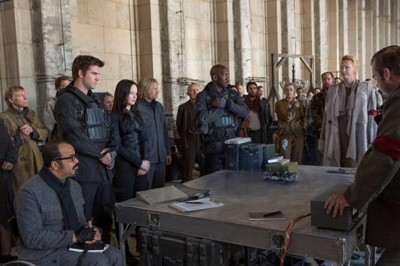 the doc capably explores the entirety of assembling this film, from the messy, wet experience of creating underground tunnels and the Hitler inspiration behind the Capitol's creation to the growth of the actors, the bombast of crafting the action, and finally bringing it all together through digital craftsmanship, scoring, and sound design. The rhythm of the material feels cohesive with the prior bonus features in the series, though the congratulatory tones have been tempered as they've gone along.
the doc capably explores the entirety of assembling this film, from the messy, wet experience of creating underground tunnels and the Hitler inspiration behind the Capitol's creation to the growth of the actors, the bombast of crafting the action, and finally bringing it all together through digital craftsmanship, scoring, and sound design. The rhythm of the material feels cohesive with the prior bonus features in the series, though the congratulatory tones have been tempered as they've gone along.
As usual, that likely would've been plenty for the Blu-ray presentation, but Lionsgate have also included a nice selection of other extras for fan of the film. The Hunger Games: A Photographic Journey (10:17, 16x9 HD) follows photographer Murray Close and his process in shooting the promotional materials for the film, complete with a wide array of his work fluctuating through the featurette. Cinna's Sketchbook: The Secret of the Mockingjay's Armor (9:22, 16x9 HD) takes a clever angle at a production featurette by taking the sketchbook created for Part 1 and elaborating on the creative process behind the outfit's conceptualization, including plenty of full-page shots of beautiful unused sketched designs. They've also included a half-featurette, half-promo called Panem on Display (1:57, 16x9 HD) about the costume and interactive experience at The Hunger Games: The Exhibition, while Jet to the Set (41:58, 16x9 HD) is a peppy high-glamour look at the locations used in the film.
Bonus Disc:
The extras on the added sixth Blu-ray disc are a strange combination of materials, containing no added features from Mockingjay Part 2 and duplicating some of the supplements already available on the standard prior releases. For the most part, however, Lionsgate have tried to include the extra features that were once exclusives from other sources, notably from Target's bonus DVD discs. It's a trove of press-kit featurettes, behind-the-scenes footage, a few new never-seen deleted scenes, and other goodies, all in low-grade HD imagery.
For some reason, the section for The Hunger Games essentially replicates the entirety of the extras from the standard special features bonus disc, including the two-hour The World is Watching: Making The Hunger Games documentary. More pertinently, it also includes the exclusive features from Disc 3 in the Target edition: Stories from the Tributes (17:47); Casting the Tributes (10:2); Tribute Video Diaries (16:46, 16x9 HD), and an in-motion Photo Album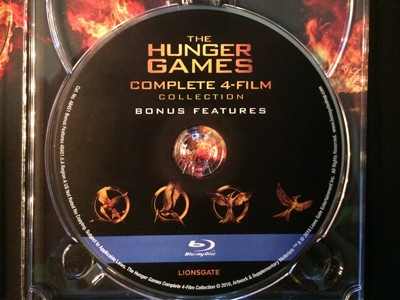 (3:10). We've also got a slate of other self-explanatory featurettes with a bunch of nice interviews and behind-the-scenes clips: Stunts of The Hunger Games (14:56), Capitol Couture (17:54, 16x9 HD), Weapons of the Arena (6:47, 16x9 HD), Effected: The Visual Artwork of The Hunger Games (10:10), and Feast and Famine: Creating the Food for The Hunger Games (6:58), Also included are a series of never-before-seen Deleted Scenes (21:14), On the Black Carpet: The Hunger Games Premiere (4:45), and a text based Easter Egg from the original Blu-ray.
(3:10). We've also got a slate of other self-explanatory featurettes with a bunch of nice interviews and behind-the-scenes clips: Stunts of The Hunger Games (14:56), Capitol Couture (17:54, 16x9 HD), Weapons of the Arena (6:47, 16x9 HD), Effected: The Visual Artwork of The Hunger Games (10:10), and Feast and Famine: Creating the Food for The Hunger Games (6:58), Also included are a series of never-before-seen Deleted Scenes (21:14), On the Black Carpet: The Hunger Games Premiere (4:45), and a text based Easter Egg from the original Blu-ray.
The first three extra pertaining to Catching Fire can all be found on their respective Target bonus disc. Per our review: "The Alliance (14:27) covers the central cast members and their experiences in continuing into a second film; Friend or Foe (18:24) delves into characters new and old whose allegiance to the tributes is questionable; and One Vision (12:37) hones in on adapting Suzanne Collins' novel as accurately as possible." Aside from those, however, the extras about this entry are slim, brief press-kit blurbs with intermittent nuggets of interest between generous clips from the film: The Look of The Hunger Games: Catching Fire (3:14, 16x9 HD), The Quarter Quell Cast (3:12), Bringing Panem to Life (6:05), Taking Aim: Stunts and Weapons (5:54, 16x9 HD), The Quell: On Location in Hawaii (5:03), and Battling the Clock Arena (5:33). Also included is the Coldplay Atlas Music Video (4:01), a food stylist-focused Capitol Cuisine 4:55) piece, and Inside District 12: The Hob (2:12).
The add-ons for Mockingjay Part 1 are even slimmer, once again bringing over the exclusive extras from the Target bonus disc but offering little else for those who already own it. Similarly to the other featurettes, these splice together pertinent clips from the film with interviews and a few behind-the-scenes shots: Rubble and Ashes (9:13) touches on set and art concepts for designing the warzone; Utilitarian Chic (13:38) revolves around the costume and makeup aesthetics of the grim atmosphere; The Propos Team (11:57) sheds some light on Natalie Dormer's character Cressida and her documentarian crew; and Combat Zone (11:51)Katniss Propo Video (0:19) recorded in the film, and Picturing Panem (7:50), which features promo photographer Murray Close offering some commentary on photos throughout the series.
Final Thoughts:
Two excellent films and two serviceable films that should've been one make up the Hunger Games franchise, which delivers even doses of enthralling themes and raw entertainment value within a dystopian young-adult setting. Those who already own the films on Blu-ray -- especially the Target exclusive discs -- will only see marginal additions in the supplemental features for the series; those who have never purchased any of the films will find an attractive, absolutely packed-to-the-brim and definitive arrangement of content here. Recommended.
Thomas Spurlin, Staff Reviewer -- DVDTalk Reviews | Personal Blog/Site
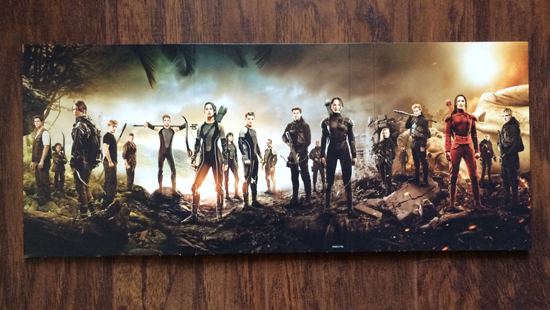 |
The stars aligned almost perfectly when the creative process began for The Hunger Games, an adaptation of Suzanne Collins' trilogy of young-adult dystopian books. As the author was finishing up the final novel, the Harry Potter film franchise was coming to an end, leaving a void in the cinema world for a new pop-culture series that fit in with a similar target audience. Jennifer Lawrence was cast in the role of Katniss Everdeen, the teenage heroine who would eventually become the spirit of an uprising, right around the time she received an Oscar nomination and was gearing up to play one of the primary mutants in the latest X-Men film. It hasn't been all apple tarts and white roses for the series since then, though, brushing with some kind of mild controversy every step of the way toward the Capitol, from concerns over the violence toward children and racial casting to the switch in directors mid-series. That didn't stop The Hunger Games from becoming its own worldwide phenomenon, and while consistency isn't its strong suit, there's plenty of meaningful exhilaration found in its four entries.
Director Gary Ross can be attributed to lighting the spark that started it all with The Hunger Games, bringing his experience with intimate, resolute drama to the world of Panem. While his enthusiasm toward evoking realism in the setting led to a consistent amount of shaky camerawork that could, occasionally, be distracting, there was a very clear focus on the new emotions erupting in Katniss Everdeen, the sixteen-year-old who volunteers to take her sisters place in the Reaping, the annual government-orchestrated, to-
 the-death battle royale among randomly-chosen youths. Through the spectacle of the Games -- the beautification and training of the young contestants, the glorification of the violence ultimately unleashed between them in the area, and the use of on-screen romance as a tool for popularity -- the film captures Suzanne Collins' commentary on media manipulation and pop-culture's fascination with reality TV and violence. With Lawrence's obstinate determination as Katniss driving the character through the bloodshed in this haunting new dystopian atmosphere, it transforms into a meaningful and intense adaptation.
the-death battle royale among randomly-chosen youths. Through the spectacle of the Games -- the beautification and training of the young contestants, the glorification of the violence ultimately unleashed between them in the area, and the use of on-screen romance as a tool for popularity -- the film captures Suzanne Collins' commentary on media manipulation and pop-culture's fascination with reality TV and violence. With Lawrence's obstinate determination as Katniss driving the character through the bloodshed in this haunting new dystopian atmosphere, it transforms into a meaningful and intense adaptation. Concerns surfaced when director Ross didn't volunteer to return to the world of Panem, later replaced by I Am Legend director Francis Lawrence, setting the franchise up for potential inconsistency and arguable fluctuations in quality. Surprisingly, the second installment, Catching Fire, takes the familiar components of Collins' book (and the first film) and improves upon them, focusing on the mental anguish suffered by Katniss in the previous games and how she's transforming into the face of a rebellion alongside her condition. A second, more violent and morbidly creative games ensues, and while there's some resemblance in the structure of the plot between the two stories, the progressing themes of oppressive government control and the twisting of public perceptions takes the tone in an invigorating, dangerous direction. Complimented by Jennifer Lawrence's addled embodiment of post-traumatic stress and a vivid, twist-heavy second round in the Hunger Games arena designed by Philip Seymour Hoffman's gamemaker, Catching Fire stands firm as the strongest entry in the series.
Following the box-office savvy trend set by Harry Potter and Twilight, Mockingjay took the unfortunate turn into splitting up the third installment of Suzanne Collins' novel series -- one that already had received mixed reviews -- into two halves. The positive of this could've potentially come in director Francis Lawrence dedicating more time to elevating the buildup to the harrowing grand finale, granting Katniss more time to decompress following her continued ordeals and sort out her relationships. What instead happens, as can be predicted, is a straight, elongated division of the book: Mockingjay Part 1 struggles to fill its time with pertinent information and excitement, resulting in two hours of drab buildup around the young heroine losing her agency and becoming a weapon for the resistance. While the shift makes sense, it's a stark deviation from the stories of the previous Hunger Games films, and that isn't helped by the fact that the action side of the final novel lies waiting in the second half. Like this, Part 1 feels like little more than anticipation, a serviceable prologue to revolution that doesn't achieve enough to justify the expanded time.
The Hunger Games: Mockingjay Part 2
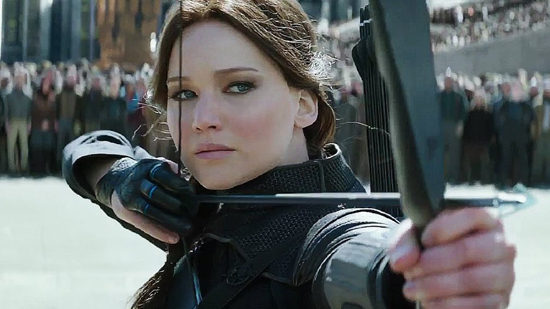 |
The writing was on the wall as soon as the announcement was made: that the third book in Suzanne Collins' Hunger Games series, "Mockingjay", would be split into two films. The idea is intrinsically flawed, driving a partition somewhere in the middle -- around the rising action -- of a story that's built with a beginning and an end, leaving one standalone film to concentrate on the build-up and the other as the payoff. It was a disheartening creative decision, especially after director Francis Lawrence surprised audiences with Catching Fire, often considered to have improved upon the successes of the first Hunger Games. Yet, the possibility arose that, perhaps, the added length and the cinematic format might better realize the material that received a polarized response from the series' fans, giving the first half more substance and purpose while more clearly visualizing the vigorous war-torn second half. Alas, the division was clearly apparent in the dreary and unsatisfying Mockingjay Part 1, leaving Part 2 to follow through roughly as expected: two-plus hours of danger, death, and despair that'd have more impact had it seamlessly flowed from the first.
Naturally, Mockingjay: Part 2 picks up immediately after the abrupt ending of the previous film (which should be viewed before continuing with this review), where resistance leader Coin (Julianne Moore) announced plans to move forward on the Capitol and where the group of Hunger Games victors who were captured by President Snow's forces -- including Peeta Mellark (Josh Hutcherson) -- have been rescued and brought to the fabled District 13. There's little else to do at this point than for the face of the resistance, Katniss Everdeen (Jennifer Lawrence), to lead her push onto the
 Capitol, though the conflicted attitudes within the resistance leave her in a state of flux as to whether she's supposed to kill Snow (Donald Sutherland) or not. Katniss, ever decisive and rebellious, makes her own choices about what to do once the troops arrive in the landscape of the Capitol, which has been rigged into a grand spectacle of violent traps for the resistance fighters to progress through, quite similarly to that of another spectacle in the Hunger Games.
Capitol, though the conflicted attitudes within the resistance leave her in a state of flux as to whether she's supposed to kill Snow (Donald Sutherland) or not. Katniss, ever decisive and rebellious, makes her own choices about what to do once the troops arrive in the landscape of the Capitol, which has been rigged into a grand spectacle of violent traps for the resistance fighters to progress through, quite similarly to that of another spectacle in the Hunger Games. By virtue of being the response to the events in Mockingjay Part 1 and the grand finale in a series about political and paramilitary rebellion, it's unsurprising that Mockingjay Part 2 revolves almost entirely around the brutal action of the storm upon the Capitol. Despite complex character moments beforehand that heighten the emotional gravity of the events to come, there's no stopping the momentum forcing the film forward, as if very little has a purpose beyond spurring Katniss toward her duty. While that's part and parcel with the division of stories, the script from Peter Craig and Daniel Strong also relies on an exorbitant amount of dull exposition to elaborate on what's going on, failing to elevate the inherently grim tone of warfare leading the resistance forward. Beyond the scenes with Peeta, driven by an unleashed and wild-eyed performance from Josh Hutcherson whose character now suffers from his own post-trauma distortion, there's a stony and generally obligatory attitude about the second part here. The intentionally silent presence of Philip Seymour Hoffman doesn't help.
Across the Hunger Games series, Katniss Everdeen transforms dramatically, erupting from a emotional sister who stands in for her sibling in the face of certain death into a warrior with PTSD and, eventually, to the televised face of rebellion against dictatorship. Mockingjay Part 2 marks the end product of her trials, and it isn't pretty: born of necessity, she's become severe and driven by vengeance, sustaining her composure for the good of those around her. It's a
 logical metamorphosis, of course, but it also takes away from the enlivened strength that Lawrence's acting ability brought to the table, relying more on suppressed -- often nondescript -- expressions of anguish. There's strength in that, depicting a resolute woman who steels herself for the betterment of her comrades: for her sister, a burgeoning medic; for Peeta, whose brainwashing has given him murderous tendencies; and for Gale, who turned pragmatically ruthless for the sake of the resistance after the destruction of his home. Outside of a few fiery scenes where Katniss is (finally) allowed to let her guard down, this is a stark -- numbed, even -- portrayal that's tough to relish.
logical metamorphosis, of course, but it also takes away from the enlivened strength that Lawrence's acting ability brought to the table, relying more on suppressed -- often nondescript -- expressions of anguish. There's strength in that, depicting a resolute woman who steels herself for the betterment of her comrades: for her sister, a burgeoning medic; for Peeta, whose brainwashing has given him murderous tendencies; and for Gale, who turned pragmatically ruthless for the sake of the resistance after the destruction of his home. Outside of a few fiery scenes where Katniss is (finally) allowed to let her guard down, this is a stark -- numbed, even -- portrayal that's tough to relish. The vast majority of Mockingjay Part 2 revolves around this despondent Katniss leading the physical uprising throughout the Capitol, which President Snow has shaped into a grand spectacle by setting vicious booby-traps throughout the city to thwart their efforts. In essence, that becomes the final version of the "games" within the series, and it doesn't shy away from bountiful violence and death within the space of a PG-13 film. Collins' third book struggled in this area: while her writing style capably fleshed out the creativity of gamemaker arenas, her depiction of the modified city streets resulted in fast-moving but obscured warfare that didn't have a firm grasp on the landscape. The cinematic medium obviously has an advantage there, and it's one of final chapter's true strengths, perpetuating the gray, crumbling atmosphere of upheaval with the dangers of liquid, fire, and bloodthirsty monsters unleashed on Katniss and her infiltrators. Fierce action ensues, and while the skirmishes and battlefield are still jumbled and not without a few holes, director Lawrence nails the harrowing blockbuster intensity.
That's also part of the problem with Mockingjay Part 2 as a whole, though: it essentially feels like the Reaping portion of the prior films has been cut off and extended into its own installment, only with Katniss descending into the warzone of districts instead of being elevated upwards through a cylindrical tube. The series' signature gloomy tones built around sacrifice, politics, and manipulation of citizens with media and propaganda weave together with the intense action, further amplified by commentary on the price of war and
 the demands of political power upon rulers. Director Lawrence and his writers bring all this together into a functional and twist-heavy commentary, yet viewing the tribulations of the resistance fighters and the lengths in which powerful figures will go to assert their grasp over the masses -- blatantly disregarding the value of life -- doesn't make for the same kind of rewarding or particularly enthralling experience found in Katniss' first bout in the arena or the Quarter Quell. The stakes are higher, but the the overcast demeanor continuously suppresses the excitement level.
the demands of political power upon rulers. Director Lawrence and his writers bring all this together into a functional and twist-heavy commentary, yet viewing the tribulations of the resistance fighters and the lengths in which powerful figures will go to assert their grasp over the masses -- blatantly disregarding the value of life -- doesn't make for the same kind of rewarding or particularly enthralling experience found in Katniss' first bout in the arena or the Quarter Quell. The stakes are higher, but the the overcast demeanor continuously suppresses the excitement level. While the final installment in the Hunger Games series certainly understands its need for closure, heightened by splendid production value behind the action and convincing, emotional performances from all involved, there's no getting around that Mockingjay Part 2 -- much in the same way as Part 1 -- runs at least a half-hour longer than it should. A tighter and more poignant depiction of the uprising against the Capitol likely exists somewhere between these overlong productions, a brisk and intense sendoff instead of an elongated elegy. What's here instead musters a generally appropriate ending that fits somewhere in the space between sorrow and bittersweet, slightly more upbeat and optimistic in tone than the book but every bit as daunting in terms of how Katniss concludes her term as the Girl on Fire. Unfortunately, that comes at the end of a four-hour storming of the castle that can't shake the feeling that it deliberately padded its runtime for the sake of a two-part theatrical showing, a disappointment considering how director Lawrence skillfully took the torch and ran with Catching Fire.
The Blu-ray:
 |  |

Packaged in a white outer box featuring the image of Jennifer Lawrence on the front and the three-finger salute silhouette on the back, The Hunger Games series comes bundled from Lionsgate in a relatively streamlined but appealing full-series box. They've taken measures to make this set not appear to be a cash grab: each of the discs, while identical in content to their respective individual releases, have unique artwork featuring the side profiles of the series' actors (posters from the first film); the foldout digipack housing for the discs comes with unique outer artwork featuring a progression from the first to final film; and a bonus disc has also been included, discussed later. The outer box has a nice mix of raised letters and glossy printing, and is thick enough to withstand a little abuse. A Digital Copy slip for all four films has also been included.
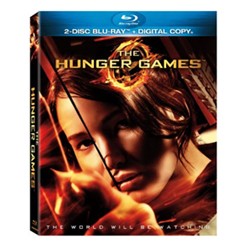 | 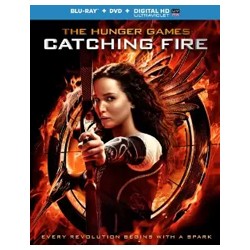 | 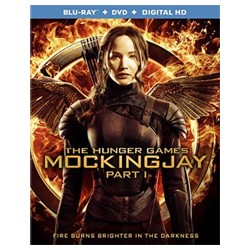 |
Video and Audio for Part 2:
Both parts of Mockingjay sport a noticeably gloomier, lower-color palette than the previous two entries, with Mockingjay Part 2 focusing even more on the crumbled, empty streets of the Capitol -- and another district -- and the dark channels lying underneath, lacking direct vividness and intricacy due to the absence of the Games. Therefore, the cinematography must find its visual delights in unconventional sources, such as the subtle teal shade of a robe in the low-color surroundings and shades of orange and yellow in fire and against walls. Lionsgate's 2.35:1-framed, 1080p AVC transfer keeps a steady perspective on that color palette, while latching onto fine textures for its high-definition delights, such as the tattoos on Natalie Dormer's shaved scalp and the weave of Katniss' body armor. Splashes of bizarre oil-like fluid and the the flood of flames create brisk-moving, well-represented details in the traps. Contrast leans light at certain points, but the depth remains largely natural and allows for distinct shots throughout the byzantine streets. The image can also appear somewhat smooth and drab throughout, part intentional and part due to the disc. In general, the impressions felt about the transfer echo those of the movie itself: not bad, but weaker than the previous installments.
Mockingjay: Part 2 storms onto Blu-ray with a Dolby Atmos track, which downscales to a fine Dolby TrueHD 7.1 track that packs more of a low-end punch than it does with immersing the surround stage with activity. Rushes of fire and floods of peculiar black fluid encompass the front end of the surround stage with vigorous activity, tapping into tight and expansive bass response. The sounds of bizarre creatures in tunnels, the zip of energy rays, and the ever-present rattling of gunfire hit robust high-end elements, while the crumble of walls and other sounds of warfare hit upon solid mid-range effects. Some surround activity does flow from the front-end to the back and vice versa, such as the zooming of the resistance's planes, but I was expecting more out of the back and back-center channels at many points throughout, leaving it sounding more front-heavy than expected. Dialogue, however, remains crystal clear and well-adjusted to middle-range balance at all points, and reacts well to the ambience of many different locations across the warzone.
Special Features for Part 2:
Commentary with Francis Lawrence and Nina Jacobsen:
If you've experienced the bonus features for the previous entries of The Hunger Games, then you'll know what to expect of this commentary with the director and producer: a laid-back discussion that does a better job at plugging up gaps of knowledge than standing out as an exciting track on its own. They touch upon the "numbed" nature of Katniss' character, the pleasure of working with a Game of Thrones star, and how much
 digital work went into creating the appearances of the people in the film (hint: it's a lot more than you'll expect). They also lightly discuss the decisions that went into separating the story into two halves and the direction they wanted to go in tandem with Suzanne Collins' wishes, having a lot of visual similarities that reference the previous films in their aesthetics, and capturing the "visceral" potency of the resistance's storm through the Capitol. The energy remains low yet steady throughout, but, as always, it's a nice supplement to the other features.
digital work went into creating the appearances of the people in the film (hint: it's a lot more than you'll expect). They also lightly discuss the decisions that went into separating the story into two halves and the direction they wanted to go in tandem with Suzanne Collins' wishes, having a lot of visual similarities that reference the previous films in their aesthetics, and capturing the "visceral" potency of the resistance's storm through the Capitol. The energy remains low yet steady throughout, but, as always, it's a nice supplement to the other features. Pawns No More: Making The Hunger Games: Mockingjay Part 2 (2:21:45, 16x9 HD):
Finishing up the series in expectedly spectacular fashion, Lionsgate have pieced together a lengthy, composed, in-depth feature about the creation of the final film, broken into several different parts depending on the focal topics that, once again, aren't like the quick five-minute blurbs tossed into other Blu-ray sets. Interviews, snippets from the script and the book itself, behind-the-scenes footage at the set creation and shooting, and pre-visualization computer imagery form into a comprehensive and insightful glimpse into the wizardry that went into the final installment, with everyone quite comfortable and acclimated to this rhythm of making-of documentary by now. Producer Nina Jacobsen and director Francis Lawrence propel the material through the division of the discussed focal points, arranged into eight specifics:
| Walking Through Fire: Concluding the Saga (13:55) Real or Not Real: Visual Design (10:31) High Value Targets: The Acting Ensemble (17:24) From Head to Toe: Costume Makeup, and Hair (14:21) | Navigating the Minefield: Production in Atlanta, Paris and Berlin (13:48) Collateral Damage Stunts, Special Effects, and Weapons (19:00) Tightening the Noose: The Post-Production Process (30:05) A Different World: Reflections (23:32) |
Longer than the film itself, this making-of documentary nails a deft balance between proper pacing and taking an in-depth look at the mechanics underneath making the film. It's bookended by chapters that attempt to explain the rationale behind splitting the story into two films, how meaningful of a political allegory the series has become, and how emotional of an experience it was to complete the project. Between that, however,
 the doc capably explores the entirety of assembling this film, from the messy, wet experience of creating underground tunnels and the Hitler inspiration behind the Capitol's creation to the growth of the actors, the bombast of crafting the action, and finally bringing it all together through digital craftsmanship, scoring, and sound design. The rhythm of the material feels cohesive with the prior bonus features in the series, though the congratulatory tones have been tempered as they've gone along.
the doc capably explores the entirety of assembling this film, from the messy, wet experience of creating underground tunnels and the Hitler inspiration behind the Capitol's creation to the growth of the actors, the bombast of crafting the action, and finally bringing it all together through digital craftsmanship, scoring, and sound design. The rhythm of the material feels cohesive with the prior bonus features in the series, though the congratulatory tones have been tempered as they've gone along. As usual, that likely would've been plenty for the Blu-ray presentation, but Lionsgate have also included a nice selection of other extras for fan of the film. The Hunger Games: A Photographic Journey (10:17, 16x9 HD) follows photographer Murray Close and his process in shooting the promotional materials for the film, complete with a wide array of his work fluctuating through the featurette. Cinna's Sketchbook: The Secret of the Mockingjay's Armor (9:22, 16x9 HD) takes a clever angle at a production featurette by taking the sketchbook created for Part 1 and elaborating on the creative process behind the outfit's conceptualization, including plenty of full-page shots of beautiful unused sketched designs. They've also included a half-featurette, half-promo called Panem on Display (1:57, 16x9 HD) about the costume and interactive experience at The Hunger Games: The Exhibition, while Jet to the Set (41:58, 16x9 HD) is a peppy high-glamour look at the locations used in the film.
Bonus Disc:
The extras on the added sixth Blu-ray disc are a strange combination of materials, containing no added features from Mockingjay Part 2 and duplicating some of the supplements already available on the standard prior releases. For the most part, however, Lionsgate have tried to include the extra features that were once exclusives from other sources, notably from Target's bonus DVD discs. It's a trove of press-kit featurettes, behind-the-scenes footage, a few new never-seen deleted scenes, and other goodies, all in low-grade HD imagery.
For some reason, the section for The Hunger Games essentially replicates the entirety of the extras from the standard special features bonus disc, including the two-hour The World is Watching: Making The Hunger Games documentary. More pertinently, it also includes the exclusive features from Disc 3 in the Target edition: Stories from the Tributes (17:47); Casting the Tributes (10:2); Tribute Video Diaries (16:46, 16x9 HD), and an in-motion Photo Album
 (3:10). We've also got a slate of other self-explanatory featurettes with a bunch of nice interviews and behind-the-scenes clips: Stunts of The Hunger Games (14:56), Capitol Couture (17:54, 16x9 HD), Weapons of the Arena (6:47, 16x9 HD), Effected: The Visual Artwork of The Hunger Games (10:10), and Feast and Famine: Creating the Food for The Hunger Games (6:58), Also included are a series of never-before-seen Deleted Scenes (21:14), On the Black Carpet: The Hunger Games Premiere (4:45), and a text based Easter Egg from the original Blu-ray.
(3:10). We've also got a slate of other self-explanatory featurettes with a bunch of nice interviews and behind-the-scenes clips: Stunts of The Hunger Games (14:56), Capitol Couture (17:54, 16x9 HD), Weapons of the Arena (6:47, 16x9 HD), Effected: The Visual Artwork of The Hunger Games (10:10), and Feast and Famine: Creating the Food for The Hunger Games (6:58), Also included are a series of never-before-seen Deleted Scenes (21:14), On the Black Carpet: The Hunger Games Premiere (4:45), and a text based Easter Egg from the original Blu-ray. The first three extra pertaining to Catching Fire can all be found on their respective Target bonus disc. Per our review: "The Alliance (14:27) covers the central cast members and their experiences in continuing into a second film; Friend or Foe (18:24) delves into characters new and old whose allegiance to the tributes is questionable; and One Vision (12:37) hones in on adapting Suzanne Collins' novel as accurately as possible." Aside from those, however, the extras about this entry are slim, brief press-kit blurbs with intermittent nuggets of interest between generous clips from the film: The Look of The Hunger Games: Catching Fire (3:14, 16x9 HD), The Quarter Quell Cast (3:12), Bringing Panem to Life (6:05), Taking Aim: Stunts and Weapons (5:54, 16x9 HD), The Quell: On Location in Hawaii (5:03), and Battling the Clock Arena (5:33). Also included is the Coldplay Atlas Music Video (4:01), a food stylist-focused Capitol Cuisine 4:55) piece, and Inside District 12: The Hob (2:12).
The add-ons for Mockingjay Part 1 are even slimmer, once again bringing over the exclusive extras from the Target bonus disc but offering little else for those who already own it. Similarly to the other featurettes, these splice together pertinent clips from the film with interviews and a few behind-the-scenes shots: Rubble and Ashes (9:13) touches on set and art concepts for designing the warzone; Utilitarian Chic (13:38) revolves around the costume and makeup aesthetics of the grim atmosphere; The Propos Team (11:57) sheds some light on Natalie Dormer's character Cressida and her documentarian crew; and Combat Zone (11:51)Katniss Propo Video (0:19) recorded in the film, and Picturing Panem (7:50), which features promo photographer Murray Close offering some commentary on photos throughout the series.
Final Thoughts:
Two excellent films and two serviceable films that should've been one make up the Hunger Games franchise, which delivers even doses of enthralling themes and raw entertainment value within a dystopian young-adult setting. Those who already own the films on Blu-ray -- especially the Target exclusive discs -- will only see marginal additions in the supplemental features for the series; those who have never purchased any of the films will find an attractive, absolutely packed-to-the-brim and definitive arrangement of content here. Recommended.
|
| Popular Reviews |
| Sponsored Links |
|
|
| Sponsored Links |
|
|
| Release List | Reviews | Shop | Newsletter | Forum | DVD Giveaways | Blu-Ray | Advertise |
|
Copyright 2024 DVDTalk.com All Rights Reserved. Legal Info, Privacy Policy, Terms of Use,
Manage Preferences,
Your Privacy Choices | |||||||














